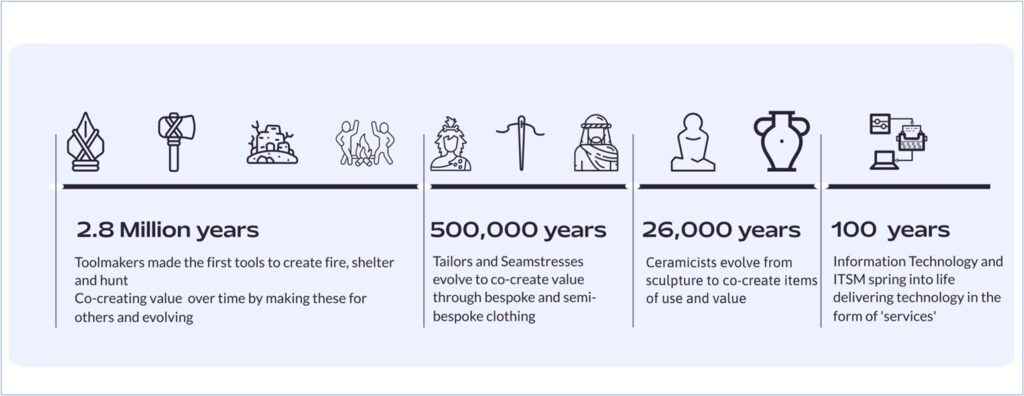By David Barrow, CITP FBCS
January 24, 2024
I want to begin by briefly examining human history regarding professions. I expect you’ll join me in recognising that Information Technology has existed for approximately 100 years. Information Technology is a young industry with several even younger career paths, one of which is Information Technology Service Management (ITSM).
It helps to cover a quick understanding of the evolution of humans and professions. A quick search via a popular search engine informs us of the following:
- Toolmaking is considered one of the world’s oldest professions at approximately 2.8 million years. Early civilisations needed to hunt and build a shelter – and hands alone were not up to the job.
- Tailors and seamstresses were recognised as professionals approximately 500,000 years ago. Looking good is the key to feeling good, something the ancient Egyptians cottoned on too early (pun intended).
- Ceramicists were recognised as professionals approximately 26,000 years ago. Cooking, eating, and drinking from solid vessels made you less likely to spill something on your finely tailored clothing.
You may argue that IT was around before the mid-1900s, but I expect you’d agree that it only existed as a profession per se in the 1940s as part of Allied war efforts during the 2nd World War. These were the first times people were working on operating technology that delivered information quickly into the hands of humans, information that could be acted upon to deliver outcomes.
As IT became mainstream in the latter half of the 20th century, so did several job roles within the industry. Most of these roles were based on aspects of IT operation, such as mainframe operation and maintenance, which later evolved into software development and commercialisation.
As governments and organisations began to utilise IT to run their organisations, the concepts of ‘services’ began to evolve. ITSM was ‘born’ with ITIL as a methodology, which was an answer to several pressing questions around the delivery of IT as a service.
Since then, IT has become a tool that has weaved its way into our everyday lives; we interact with IT daily. It’s in our homes built with tools; we catalogue, order, and deliver clothing using IT. Those vessels that were first made approximately 26,000 years ago are fired using electronic kiln controllers, or in some cases, we circumvent the need for clay through IT-driven 3D printing.
Incredibly, this ‘thing’ called IT has been weaved into our everyday lives, and yet it has only existed for 100 years, and we’ve squeezed so much out of it, but there is so much more to come.
As I’m a big fan of a picture, I enclose below a ‘not to scale’ timeline that I hope illustrates the relative ‘age’ of our IT industry and ITSM as a profession.
For over 2.8 million years, toolmaking will have evolved to the point where we all understand its value, core accountabilities and possible career path; the same applies to tailoring/seam stressing and ceramics.
By comparison, not only is IT as a profession a relative infant, but ITSM as a profession is half its age again. Yet, we have weaved our way into everyday life. No wonder we have much growing up to do, and relatively little is known about our profession.

Figure 1: A comparison of professions
As I write in 2024, ITSM has been used for approximately 40 years. ITSM is strategising, designing, and operating IT services for your colleagues and customers; it’s about handling the risk for your customers, managing the design of IT services, and co-creating value to enable desired customer outcomes. Additionally, ITSM has elements of controlled experimentation that are necessary to improve and evolve continually.
That’s a lot to take in, but this is ITSM summed up for me.
It has evolved rapidly and progressed so much that terms such as the ‘Information Age’ or ‘The 4th Industrial Revolution’ are often used. Along with this, our approaches to work are also rapidly transforming.
Take, for example, all the changes within the last few decades. It was way back in 1989 that the first version of the Information Technology Infrastructure Library, aka ITIL, emerged. ITIL was partly in response to the UK government’s desire to standardise how we deliver IT services and became the de-facto approach to what became known as ITSM.
ITIL v2 followed this in 2001, ITIL v3 in 2007, and ITIL 4 in 2019.
As ITSM evolved, so did the ways of delivering Information Technology services. LEAN processes emerged in 1991, with the Agile Manifesto launched by a group of software engineers in 2001.
Service Integration and Management, aka SIAM, was developed in 2005. An evolution was required as organisations entrusted multiple partners to deliver IT services; they needed a strategic approach to managing these suppliers via a single ‘service integrator’.
DevOps, aka Development Operations, was developed from 2007 through 2008 to improve an organisation’s way of working when it came to delivering IT applications and services in a speedy and controlled manner.
And so, as we arrive in 2024, we have witnessed an evolution occurring over approximately 40 years that continues at pace. This evolution shows no signs of slowing, but as a cautionary tale, I’d like to close by saying – we are still a young industry, but we are an industry that can learn as much from looking at our past as we can from using technology to drive our future.
Work with your people, understand their ‘values’ and use this to co-create great ITSM solutions for your colleagues and customers; if you do this, you won’t go wrong.
David Barrow has recently celebrated 30 years working in the IT ‘service’ industry, a career that began building personal computers has led to his working with high-performing global teams across multiple industries in complex environments to deliver value to their colleagues, customers, and partners.
David is an ITIL 4 Strategic Leader, recognised by BCS, The Chartered Institute for IT, as a Chartered IT Professional and Fellow. David has presented to global C-Level audiences on the ‘10 Steps to Digital Transformation’ with EXIN and the IFDC.
He is also a committee member of the British Standards Institute (BSI), British Computer Society (BCS) & International Organization for Standardization (ISO), discussing all things service management.
In 2022 David published ‘Co-creating value in organisations with ITIL 4’, released via The Stationery Office (TSO) under license by AXELOS and PeopleCert.
These words are summarised and extracted from my recently released book titled ‘An Education in Service Management’ You can learn more and buy your copy here: https://www.itgovernance.co.uk/shop/product/an-education-in-service-management-a-guide-to-building-a-successful-service-management-career-and-delivering-organisational-success
Browse IIL’s Information Technology Management Courses here!
Disclaimer: The ideas, views, and opinions expressed in this article are those of the author and do not necessarily reflect the views of International Institute for Learning or any entities they represent.



